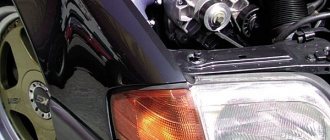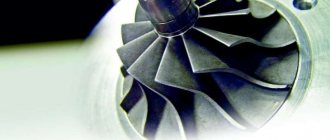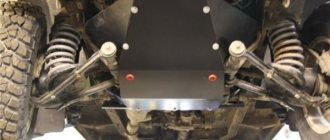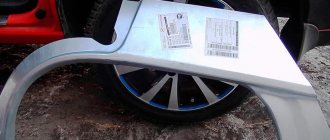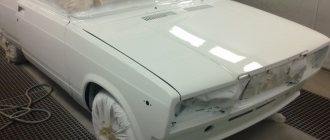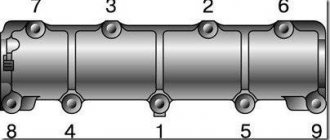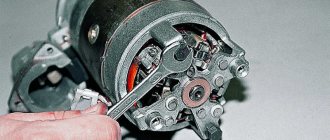The VAZ 2107 is quite good and was produced until recent years as the last of the classic Mohicans. We couldn't miss the opportunity to tell you about tuning the engine of this car. Find out the main aspects that you will encounter, and also read valuable instructions and recommendations in this matter.
If you find yourself here, you're probably thinking about how you need to improve your car, namely its engine. It is worth noting that tuning the VAZ 2107 engine is a fairly popular issue, and in this article we will look at the main areas in which you should work in order to get a significant increase in the power of a conventional classic engine.
Anyone who drives a classic understands that the stock horses under the hood are often not enough. Sometimes, when making long overtaking maneuvers or other maneuvers related to accelerating the car when there are long vehicles in the stream, car owners realize that there is a lack of horsepower. In fact, this is the main urge to change something and get out of this situation, and with the least loss of money. In this case, the car enthusiast will be helped by tuning the 2107 engine with his own hands. Most of the work to improve traction characteristics can be done yourself in the garage, but some can only be carried out by professional mechanics. Now let's talk about this in more detail and start with the cylinder head.
Mechanical supercharger for VAZ: pros and cons
The larger the engine and the more cylinders it has, the higher its power. This is the very first conclusion when observing motors and machines. But this is not always the case. The more fuel burned in the engine cylinders, the more power it can produce. But the cylinder volume is finite, and I want to have increased power. This is where a mechanical air blower comes to the rescue.
The principle of its operation is extremely simple and works on any car, including the VAZ 2107, 2106, 2114, 2112 family - it provides additional air to the engine, resulting in:
- the purging of the cylinders increases, and they are better freed from the remains of burnt fuel;
- more fuel enters the engine cylinders, which ensures more power;
- The compression ratio increases, which also gives an increase in power.
This approach is almost similar to the turbo mode used on diesel engines. Only there, for these purposes, a turbocharger is used, driven by exhaust gases, and in this case, a mechanical air blower, which is connected to the engine crankshaft by a belt. This approach is much simpler, the air supply depends on the engine speed, the higher it is, the more air is supplied; and also does not require ensuring the operating modes of the turbine and can be done with your own hands on any VAZ car.
It is worth considering that if a mechanical supercharger is installed on a VAZ injection car, then a firmware change will be required. However, a similar modification can be made for a carburetor car, only in this case, most likely, you will have to change the jets in the carburetor and adjust the ignition timing.
Do not forget that you are boosting a VAZ engine, be it any of its models 2107, 2106, 2114, 2112, the work must be carried out comprehensively, and only then is it possible to obtain the expected result. However, this is not such a big price to pay for the increase in power.
Refinement of the cylinder block
As for the VAZ 2107 cylinder block, you can install lightweight pistons
- in fact, this is the easiest and most effective way to increase the performance of the entire engine as a whole. Why is that? It's very simple - the heavier connecting rod used in the base engine creates increased inertia from reciprocating movements. Part of the engine efficiency is lost to compensate for this physical phenomenon. In general, lightweight connecting rods and pistons can significantly increase engine balancing and also reduce friction.
One of the popular ways to do engine tuning with your own hands is the so-called engine displacement increase.
. This can be achieved by boring the cylinder block itself.
However, it is worth noting that this point is very important and if you do it incorrectly, you can lose the entire motor. Basically, this procedure is performed for old, worn-out engines, which increases their overall compression.
Let's touch the light pistons
, which are initially produced at the plant by casting. However, it is best, as a tuning, to install forged ones, which are lighter and more efficient than standard ones. The forging method reduces internal stresses in the metal.
You can also install an improved collector, which is also popularly called a spider. This will reduce the combined influence of two adjacent cylinders. It allows for better ventilation or blowing of the cylinders, and therefore the resistance of the piston group will decrease and, accordingly, the engine power will increase.
Necessary elements for turbine installation
How to install an air conditioner in a car
Drivers who do not have enough power in their car decide to install a turbine. Thanks to turbocharging of an atmospheric engine, the car becomes more economical, since the engine power increases, but the volume remains unchanged. So, after installing a turbine on a 1.4-liter engine, the car behaves as if it had a 1.8-liter engine.
However, the issue must be approached with caution, since when technically improving a car, many of its important parts are affected, and additional spare parts are used. Here is a list of the main parts that will be required when installing the turbine:
Here is a list of the main parts that will be required when installing the turbine:
- the turbine itself;
- an exhaust manifold;
- intercooler to cool the air;
- air supply line, which is made of aluminum tubes or stainless steel;
- silicone pipes for connecting tubes;
- pipes for supplying coolant and oil;
- a pipe from the turbine outlet to the muffler (called a pipe or downpipe);
- high productivity nozzles;
- electronics that will control the fuel supply.
Instead of a conventional manifold, you need a turbo manifold through which the exhaust gases will pass and be directed to the turbine.
To prevent the turbine from overheating, a cooling system is installed. A lambda probe sensor (oxygen sensor) will need to be built into the pipe.
The turbine impeller speed is very high. To prevent it from malfunctioning, it is necessary to supply oil that will come from the engine. To relieve excess pressure, a special valve (blow-off) is needed.
Compressor or turbocharger
What's under the hood and how to install a new hood
So, let's start with the latter and try to figure out what is suitable for the VAZ 2107 - turbocharging or a mechanical compressor. Initially, experienced drivers, regardless of the VAZ model, advise using a compressor to increase the car’s power.
Moreover, according to experts, you need to be guided by the following advantages of the compressor:
- During installation, minimal modifications to the internal combustion engine will be required.
- The actual ease of installation of the device.
- When installing a compressor, you will not have to interfere with the operation of the lubrication and cooling systems; accordingly, the exhaust manifold will not overheat, as is the case with gas turbine supercharging.
Installing a turbine is justified on a modern imported high-speed car, which was initially designed for high power. In the case of a VAZ, the turbine will simply “kill” the engine or injector, and this will happen in a very short time. Therefore, in order to eliminate all risks for the VAZ 2107, it is initially worth considering only a mechanical compressor.
Today, there are two ways to tune the 2107 internal combustion engine: experimental or purchasing a ready-made kit. Each of them deserves a separate discussion. Therefore, first things first.
How to install an air blower yourself
There are several approaches that allow you to install a mechanical air blower on VAZ family cars with your own hands. This means making a device yourself that provides turbo mode or boosting the engine, or using a ready-made KIT kit.
Homemade supercharger for VAZ
With this approach, the mechanical air blower will be decisive. The entire future design depends on it. The main thing is to find an air supercharger from an imported car that meets the requirements, or you will have to use a homemade one. This is also possible, and in this case suitable parts and components from completely unexpected devices, for example, a vacuum cleaner, are used.
When making such a homemade air supercharger, you need to take literally everything into account - dimensions, weight, placement in the engine compartment, how and where the drive pulley and belt will be located, the performance of this device, operating modes (short-term or long-term), the possibility of lubrication and much, much more. Once the compressor becomes clear, it is necessary to calculate the implementation of the turbo mode for the engine.
Here it is necessary to take into account how the fuel and cooling system of the car will be changed, what changes need to be made to its control and how to do this, what pressure will be acceptable for safe operation of the engine when implementing a turbo mode using such a device.
Even the far from complete list of questions shown shows that making a homemade air supercharger for a VAZ of any family, be it 2107, 2106, 2114, 2112, is quite difficult, but possible. An example would be a photo showing that such work has been successfully completed. True, this is not a VAZ, but the fact itself is important - it is possible to make a homemade air compressor in which its drive unit is connected to the engine crankshaft.
Do-it-yourself drive supercharger - from a KIT kit
Yes, there are such kits on sale that allow you to implement the turbo mode in VAZ 2107, 2106, 2114, 2112 cars with your own hands. As a rule, it includes everything needed to assemble and install such a device on a car - the compressor itself, belts, drive unit , brackets and air ducts. What such a kit is like can be seen in the photo below.
The main advantage of this approach to implementing the turbo mode on your car is the simplicity and complete adaptation of technical solutions to a specific option - 2107, 2106, 2114, 2112. As a rule, the manufacturers of kit kits are Chinese manufacturers, which ensures their fairly reasonable price.
As an advantage of implementing the turbo mode in this way, it is worth noting that it is tailored specifically to VAZ cars of one model or another (2107, 2106, 2114, 2112). The advantages of this approach also include the fact that under some conditions, when the level of additional pressure created is not more than half a bar, no intervention is required in the vehicle’s fuel system.
It is inappropriate to describe the procedure for implementing the turbo mode from such a set; each of them has its own assembly instructions. The disadvantages include the country of origin, but it depends on your luck. The video will additionally help you understand what the car looks like after modification and how to carry it out. One of the ways available to car enthusiasts to boost the engine of an old car and give it a new life is to install an air supercharger. You can do this work yourself if you use commercially available KIT kits for VAZ cars.
What else is worth reading
Brake system VAZ 2112
Transfer case
Rear axle gearbox VAZ 2107
Repair of the brake system of the VAZ 2106
Installation of the KIT kit
How to install auto engine start
So, first of all, let's figure out what it is - a KIT kit. In fact, this is a ready-made kit for tuning the VAZ 2107 engine. It consists of a compressor, which was originally selected specifically for the VAZ, as well as all other components necessary for modernization.
KIT kit
The most important nuance here is that almost any driver will be able to install the system independently. The kits themselves are divided into two types - Chinese and European production. The latter are again very expensive and may require firmware updating of the on-board computer. Therefore, we will dwell in more detail on sets from the Middle Kingdom.
Let's take for example the sc-vaz compressor, designed specifically for the VAZ 2107. When purchasing such a product, absolutely no modifications to the engine will be required, unlike European originals. The Chinese was designed specifically for the seventh model Lada and is installed without any modifications. In addition to the fact that this device will be cheaper than all other options. Any car enthusiast whose hands grow, as they say, from the right place will be able to install it. In addition, the compressor can be dismantled and sold at any time.
If you are on a limited budget, the choice is obvious; you can only afford a mechanism from the Middle Kingdom. Its price rarely exceeds 700–800 USD. e. A European one will cost about 2,000 thousand, plus it will require an individual approach during installation.
If you don’t have financial problems, don’t rush into buying expensive tuning kits right away. First, decide what you expect from the car after installing the KIT kit. If this is just a transition period before buying a more powerful car, the Chinese will be enough for you. But if you are going to participate in competitions among Zhiguli classics in a VAZ 2107, or are a member of a car club of this brand. You can also think about a more serious investment. In this case, you will receive a truly charged car with the ability to change or adjust engine characteristics depending on the situation. However, be prepared for the fact that you will have to shell out a very large sum; for example, there have been cases when VAZ 2107 fans invested the cost of a premium foreign car in their cars.
What's better?
The answer to this question can only be given by the owner of the VAZ 2107. A cheaper option would be to install a conventional compressor. It won't take much time or money.
But if you want your car to “fly”, then you need to install a turbine.
As stated above, this is a more complex procedure in which you will need to change some components of the car and invest a lot of money in such tuning. But you will definitely be pleased with the result.
Why install a turbine
When they say “atmospheric engine,” they mean a conventional internal combustion engine into which air enters naturally without additional devices. Air is mixed with gasoline or other fuel, enters the cylinder, ignites from a spark, resulting in work being done. Due to this work, the car runs.
An engine to which a turbine is connected is called turbocharged. Cars with turbocharged engines first appeared in the middle of the last century.
| Advantages of a naturally aspirated engine | Pros of a turbocharged engine |
| Wear resistance | Higher power with the same volume as a naturally aspirated engine |
| Easy to use | More torque |
| Possibility of multiple repairs | More environmentally friendly |
The turbine operates due to the exhaust gases that enter it. As it rotates, it creates air pressure supplied to the cylinders, that is, the air no longer flows by gravity. The fuel mixture becomes more saturated with air and burns more intensely. Turbocharging can increase engine power by 10%, and in some cases more.
The disadvantages of a turbocharged engine include greater demands on the quality of oil and fuel. Engine oil and oil filters need to be changed twice as often because the turbocharger operates at high temperatures. For stable operation of the device, you must constantly monitor the air filter.
In addition to the turbine, to increase the power of the engine, you can install a compressor on it, which will pump air. The compressor drive is connected to the crankshaft. The compressor does not increase the temperature because it does not use exhaust gas, but it reduces the useful work of the engine.
In general, installing a compressor is considered a simpler task than installing a turbine. When faced with the question of whether to choose a compressor or a turbine, car owners often lean towards the first option.
Screw type
This is a more advanced and reliable supercharger design. The principle of operation here is also simple - compression occurs by changing the volume of the cavities between the body and the rotation screws (a kind of rotors). The air here moves diagonally. The big advantages of this option are high efficiency up to 85%, as well as high air pressure (from 1 bar to higher), this is achieved by high speeds, sometimes up to 12,000 rpm. It is because of this that the body can be made more miniature. It must be said that this option is often used on racing cars due to its reliability and small body.
The only downsides are the complex structure and repairs, which increases the price of the final product. If such a drive compressor fails, it needs to be repaired at specialized stations, preferably from the manufacturer.
As you can see in the design there are two rotors, with serrated spiral teeth. Their profiles fully correspond to each other when in contact, which makes the design very reliable.
Turbine installation
Whether it is possible to install a turbine on a car depends on the specific car model. In some cases, it is easier to purchase a new car than to select spare parts. If you decide to do this, then find a good technician, because it’s quite difficult to handle the installation yourself.
The conversion process begins with the removal of all parts in the car related to the air intake and exhaust. The new turbo manifold is connected to the turbine, which is deployed so that work with connecting the pipes is simplified as much as possible.
The bearings of a turbine that rotates at high speed constantly need lubrication. The oil supply pipe is connected to the place in the engine where the oil comes under pressure.
You can also use the oil pressure sensor tee for connection. The other end of the tube is connected to the top of the turbine cartridge. The oil will drain under low pressure into the pan through a special nipple. The cooling system will be connected on the other side of the water pump.
As more air enters the engine, it will require more fuel. To increase its flow, more efficient nozzles are installed. It also wouldn't hurt to install a new fuel pump that matches the injectors. But whether to do this is decided on a case-by-case basis.
Excessive air pressure in the engine will be controlled electronically. Coolant and air temperature sensors are connected to it. The controller must be calibrated so that fuel is injected at exactly the right time based on the engine condition.
The firmware of the motor should be done by a specialist with extensive experience behind him. Otherwise, by changing the factory settings, you can render the engine inoperative, and then spend money on repairing it.
If a compressor is installed on the car, the setup will be much easier. You won't need so many additional parts. It will be able to work at low and high speeds.
In general, the conversion process is quite labor-intensive and requires skills. Accordingly, the price of the issue will be high. Whether you need this, decide for yourself. But with successful installation of the turbine, the dynamic characteristics of the car are significantly improved.
Compressor from internal combustion engine. Option 1
Entry by admin - December 29,
DIY compressor
I already wrote about the compressor that I use in car repairs, but this compressor is somehow suitable for painting, but cannot cope with my growing requirements. In particular, I needed a compressor to work with an orbital sander.
I found a way out, or rather not so much a way out as probably a field for experimentation :) Do-it-yourself compressor from an internal combustion engine I already wrote about the compressor that I use in painting cars, but as it turned out, this compressor is not suitable for working with a pneumatic orbital machine. The Chinese compressor cannot cope with the air flow of the orbital machine; a receiver fully inflated to 8 atmospheres is enough for 1 - 1.5 minutes of operation of the machine, or even less.
Not okay. I read on Stardrive about a compressor from an internal combustion engine, there the guys used an engine from a VAZ, the performance was around 1000 l/min. It’s good, but I don’t have anywhere to put it yet, and it’s not that easy to make.
Another option came to my mind, to use an engine that was previously used to drive various agricultural equipment (machines, etc.) - its marking is ZID 4.5. Another important aspect in favor of this internal combustion engine is lubrication - oil is poured into the sump and circulates in the engine, and the cooling is also quite good - when running for about 1 hour, the compressor is slightly warm. If I’m not mistaken, then its working volume is 500 cm3, which is not little, only slightly less than in the CO-7 compressor.
This engine is a four-stroke, so there are valves. Those who know how a 4-stroke engine works will understand that when using the engine as a compressor, the useful power stroke (air injection) is one for two crankshaft revolutions.
This is when using the conventional gas distribution system of the ZID engine, I used this one. This leads to a decrease in performance, but for my purposes the compressor was quite suitable.
How to make a compressor from an internal combustion engine?
- To begin with, we need to drive this motor, for this I used a 4 kW electric motor, although it was possible to take 3 kW, naturally 380 V. I think it is possible to drive such a compressor from 220 V, but you need to play with the pulleys and you will not get such performance as on 380. The pulley on the compressor was original, on the engine it is a little larger, the speed on the compressor shaft is about 1300 rpm. Each compressor is equipped with a check valve, this valve makes it possible to push out the volume of air during the working stroke of the piston and will not return back into the cylinder. When making homemade compressors, this is one of the biggest problems, finding and adapting. I found a solution, perhaps not ideal, but quite simple and does not require turning work, and without interfering with the design of the engine, it can be easily returned to normal operating mode.
To make a check valve, we need a spark plug from this engine, a ball from a bearing, a spring (selected experimentally), a metal tube, and welding. The spark plug must be knocked out (remove the insulator) so that only the metal part remains.
Next, we take a ball from a bearing of a suitable diameter, here it is worth understanding that the ball must tightly close the hole in the cylinder and not jam, at the same time be sealed. We clamp the spark plug in a vice and with several gentle blows we fill the seat of the ball. The spark plug is prepared for the check valve. The ball is in the seat of the check valve. Next, we weld a tube to the metal part of the spark plug, I used a piston pin from a VAZ engine, I just cut a window on the side for the tube. Check valve parts for the compressor Plug at the top I made it from a part of the speaker. As you may have guessed, the valve will be screwed in instead of a spark plug, without any modifications to the engine.
I selected the length of the spring experimentally, as well as the width, but the ball is pressed quite tightly. As you can see in the photo above, I welded a threaded connection from the hydraulics of some car to the tube, then there is 1.5 meters of tube, then a straight hose to the orbital machine. I used a compressor without any receiver, a 12 mm by 5 m hose directly to the machine, compressor I provided it completely, it was a pleasure to work, but it was impossible to stop until you turned off the compressor :) Next, I will remake the compressor for permanent use, so it will be interesting to stay tuned for new posts!
